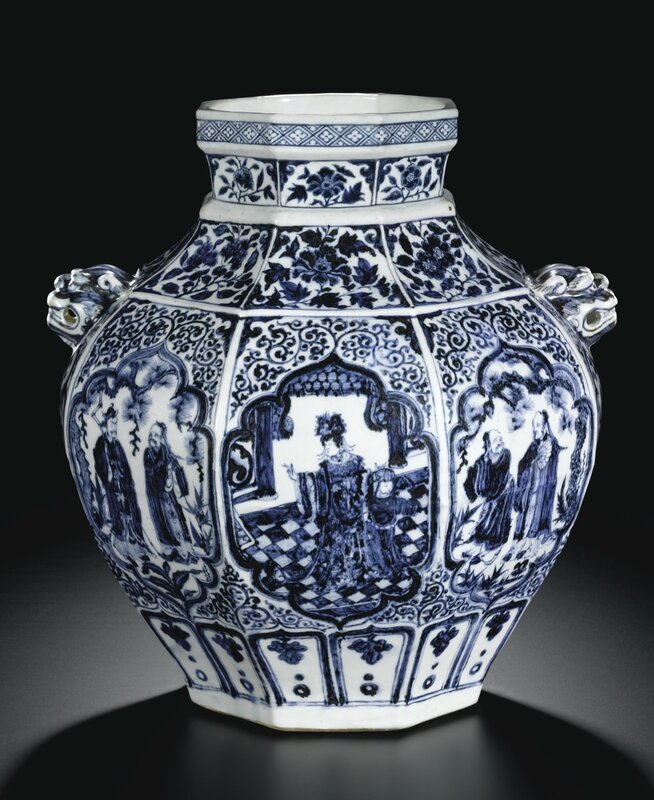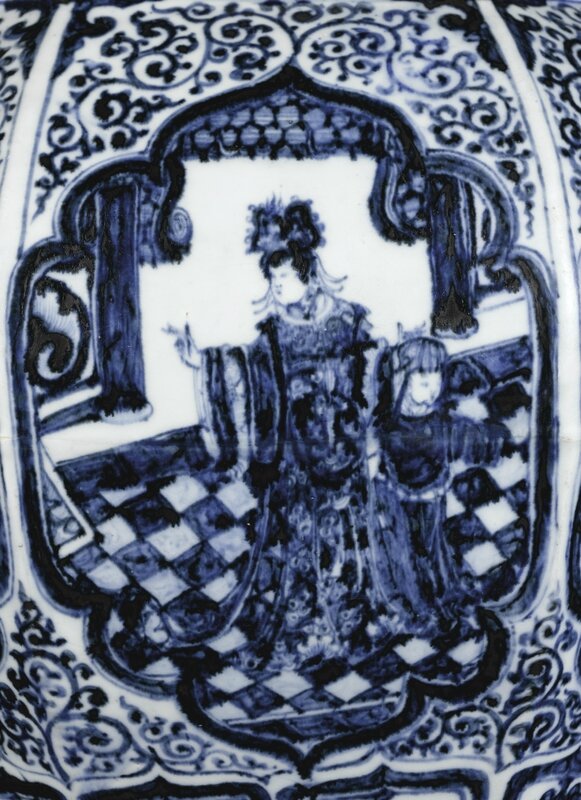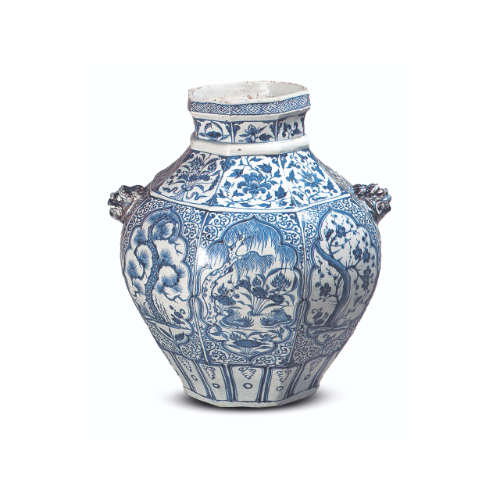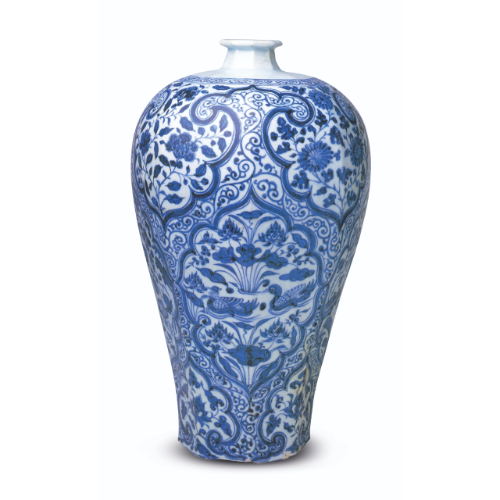An important blue and white 'daoist immortal' jar, Guan. Yuan dynasty
An important blue and white 'daoist immortal' jar, Guan. Yuan dynasty. Estimation 10,000,000-15,000,000 HKD. Unsold. photo Sotheby's
of octagonal baluster form, with rounded faceted sides rising from a slightly waisted base to a shoulder collar and a towering neck, set with two moulded and pierced animal head handles on the sides, superbly painted around the body in a deep cobalt blue with intense 'heaping and piling', the broad centre with eight barbed pointed panels among knobby scrollwork, depicting Xiwangmu on both sides, surrounded by the Eight Immortals, with the 'Three Friends of Winter' below the handles, the Queen Mother of the West on one side seated on a throne dressed in a patterned garment with billowing scarves, an attendant presenting her with a basket of peaches, flanked by four immortals dressed in leaf capes, probably showing Li Tieguai with a gourd hanging from a tall travelling frame on his back, together with Zhang Guolao with his bamboo tube drum, and Cao Guojiu with his clappers paired with Lan Caihe carrying a hoe and a basket with lingzhi on his back, and on the other side Xiwangmu standing on a tiled terrace accompanied by a boy, dressed in opulent flowing robes and wearing a bejewelled crown, between cartouches enclosing four aged immortals wearing long robes, one holding a staff, and another, perhaps Zhongli Quan, a fan, all above a band of upright lappets skirting the foot and below eight floral panels collaring the sloped shoulder, the reconstructed neck similarly painted with cartouches of composite flowers and a diaper pattern on the flanged rim, the shallow recessed base unglazed; 38 cm., 15 in.
Daoist Immortals Under Mongol Rule. Regina Krahl
This jar with its lively depiction of Daoist immortals is unique; no other jar of this form painted with any kind of figure scene appears to be recorded, and any depictions of Daoist subjects are extremely rare in the Yuan dynasty.
Octagonal jars set with pairs of animal masks pierced to hold metal rings and decorated with barbed panels among knobby scrollwork, represent archetypal artifacts of the Yuan dynasty. The complex shape and the vigorous style of this early cobalt painting, whose liveliness and boldness were never again matched in later periods, embody the innovative ways of Yuan potters, which made Yuan blue-and-white popular worldwide.
Although the Mongol court had an ambivalent relationship to Daoism and its practitioners, this philosophy-turnedreligion played a not insubstantial role in Yuan society and may have served as a helpful intermediary between the Mongol rulers and the Chinese populace at large, and in the south the disenchanted Chinese literati who had served the Southern Song court before and were now largely excluded from government posts. Yet, according to Birgitta Augustin, "Very little Daoist art [defined as "either representing Daoist content or made by Daoists"] from the thirteenth and fourteenth centuries has survived." ('The Daoist Image: Portrait of the Immortal' in James C.Y. Watt, ed., The World of Khubilai Khan. Chinese Art in the Yuan Dynasty, The Metropolitan Museum of Art, New York, 2010, p. 129).
As a composite group the Eight Immortals had perhaps appeared only a century or so before this jar was made, and were still only rarely represented in the Yuan dynasty. The present depiction is particularly unorthodox in showing four of the eight in long robes, and the other four in leaf capes, although both forms of representation are known on their own. Related immortals in long robes can be seen, for example in a painting attributed to Yan Hui of c. 1300, preserved in the MOA Museum of Art Atami, Shizuoka, and included in the Metropolitan Museum exhibition, ibid. fig. 166, showing Zhongli Quan initiating Lü Dongbin into the Secret of Immortality (fig. 1); and an immortal in a leaf cape appears in a 14th-century painting attributed to Chen Yuexi in the Museum of Fine Arts, Boston, included in the same exhibition, ibid., fig. 171, which is said to represent the Daoist Immortal Magu, but is reminiscent of the present depiction of Lan Caihe with flower basket and hoe (fig. 2).
fig. 1. Yan Hui, The Daoist Immortal Yunfang Initiating Lü Chunyang Into The Secret of Immortality, Hanging Scroll, Yuan Dynasty, Early 14th Century, Moa Museum of Art Atami, Shizuoka
fig. 2. Chen Yuexi, the Daoist Immortal Magu with a Crane and Flower Basket, Hanging Scroll, Yuan Dynasty, 14th Century. Museum of Fine Arts, Boston
In its shape and general layout the jar is very close to the famous octagonal jar in the Liaoning Provincial Museum, Shenyang, which shows basically the same kind of decoration but the panels on two sides depicting mandarin ducks in a lotus pond and on the other sides bamboo, prunus and pine, all among similar knobby scroll work and with similar flower sprays on the shoulder (fig. 3). That jar, which has been frequently illustrated, for example, in Zhongguo taoci quanji [Complete series on Chinese ceramics], Shanghai, 1999-2000, vol. 11, pl. 149, was recently included in the exhibition Yuan qinghua / Blue and White of the Yuan, Capital Museum, Beijing, 2009, catalogue pp. 54-7, where it is also illustrated on the cover. A related jar with its handles missing, painted with panels depicting fabulous animals and birds, was sold at Christie's Hong Kong, 23rd March 1993, lot 708; another with panels of flowers and fruit, discovered in Thailand, is published in Ye Peilan, Yuandai ciqi [Porcelain of the Yuan dynasty], Beijing, 1998, p. 308, fig. 95, where the author remarks (p. 307) that the Thai King Ram Khamhaeng (r. 1278-98) twice asked at the Yuan capital, Dadu, for potters to teach the Chinese methods.
fig. 3. Blue and White Jar, Yuan Dynasty, Liaoning Provincial Museum, Shenyang
In its general style this octagonal vessel with its horror-vacui decoration is also closely related to two octagonal meiping as well as a vase that combines the meiping and guan forms, all similarly decorated with barbed pointed panels among knobby scrollwork. One such meiping, painted with mandarin ducks in a lotus pond and garden scenes, is in the Topkapi Saray Museum, Istanbul, illustrated in Regina Krahl, Chinese Ceramics in the Topkapi Saray Museum, Istanbul, ed. John Ayers, London, 1986, vol. II, col. pl. 575 (fig. 4); the companion piece, from the collection of Frederick M. Mayer and today in the Matsuoka Museum of Art, Tokyo, showing phoenixes and garden scenes with insects, was sold at Christie's London 24th June 1974, lot 77, and included in the exhibition Ty tji meihin zuroku [Illustrated catalogue of masterpieces of Oriental ceramics], Matsuoka Museum of Art, Tokyo, 1991, cat. no. 54. The Matsuoka vase is illustrated again in Mikami Tsugio, ed., Sekai tji zensh / Ceramic Art of the World, vol.XIII: Ry, Kin, Gen / Liao, Chin and Yüan Dynasties, Tokyo, 1981, col. pl. 199, together with a meiping-style vase with wide guantype neck in the Fitzwilliam Museum, Cambridge, painted with six panels with phoenixes among similar scrollwork, col. pl. 203 (fig. 5).
fig. 4. Blue and White Meiping, Yuan Dynasty, Topkapi Saray Museum, Istanbul, Turkey
fig. 5. Blue and White Meiping-style Vase with Guan-type Neck, Yuan Dynasty, 14th Century, Fitzwilliam Museum, Cambridge
Figure scenes are extremely rare on Yuan blue-and-white, and those that are known generally depict scenes from contemporary plays. An exception are two meiping preserved in Hubei, one discovered in the tomb of Zhu Dong, a son of the Hongwu Emperor (r. 1368-98), and now in the Hubei Provincial Museum, Wuhan (fig. 6), the other in the Wuhan City Museum, both painted with the Four Predilections (si ai), depicting four famous scholars with the plants and birds they were known to be particularly fond of. These vases are, however, more loosely painted and would appear to be somewhat later in date; see the Capital Museum exhibition catalogue, op.cit., pp. 17-23. Similar decoration was in this period also executed in metal, and a silver-gilt yuhuchun ping from the Dexing Municipal Museum, Jiangxi province, also depicting the si ai figure scenes in barbed panels, was included in the Metropolitan Museum exhibition, op. cit., fig. 312, together with one of the Hubei vases, fig. 323.
fig. 6. Blue and White ‘Four Predilections’ Meiping, Yuan Dynasty, Excavated from the Tomb of Zhu Dong, Hubei Provincial Museum, Wuhan
Sotheby's. Fine Chinese Ceramics & Works of Art. Hong Kong | 04 avr. 2012 www.sothebys.com

/https%3A%2F%2Fprofilepics.canalblog.com%2Fprofilepics%2F1%2F0%2F100183.jpg)
/https%3A%2F%2Fstorage.canalblog.com%2F03%2F02%2F119589%2F96711876_o.jpg)
/https%3A%2F%2Fstorage.canalblog.com%2F11%2F31%2F119589%2F94773502_o.jpg)
/https%3A%2F%2Fstorage.canalblog.com%2F20%2F83%2F119589%2F94772815_o.jpg)
/https%3A%2F%2Fstorage.canalblog.com%2F26%2F72%2F119589%2F75604929_o.jpg)
/https%3A%2F%2Fstorage.canalblog.com%2F59%2F60%2F119589%2F26458628_o.jpg)















/image%2F1371349%2F20240416%2Fob_2a8420_437713933-1652609748842371-16764302136.jpg)
/image%2F1371349%2F20240414%2Fob_83ee65_2024-nyr-22642-0954-000-a-blue-and-whi.jpg)
/image%2F1371349%2F20240414%2Fob_15808c_2024-nyr-22642-0953-000-a-blue-and-whi.jpg)
/image%2F1371349%2F20240414%2Fob_e54295_2024-nyr-22642-0952-000-a-rare-blue-an.jpg)